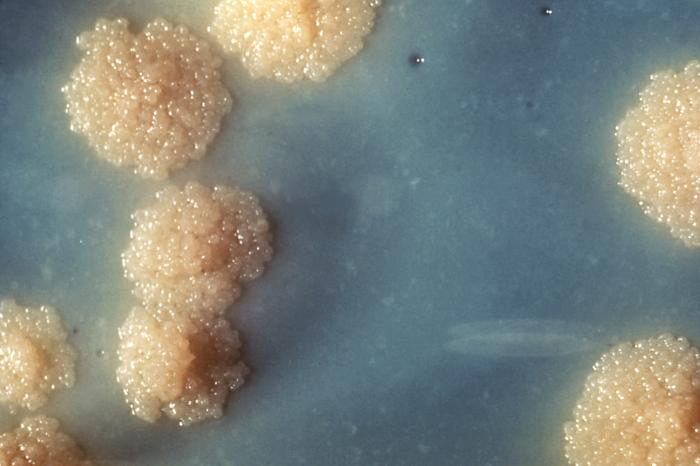| << Chapter < Page | Chapter >> Page > |
[link] summarizes the characteristics of notable genera low G+C Gram-positive bacteria.
| Bacilli: Low G+C Gram-Positive Bacteria | ||
|---|---|---|
| Example Genus | Microscopic Morphology | Unique Characteristics |
| Bacillus | Large, gram-positive bacillus | Aerobes or facultative anaerobes; form endospores; B. anthracis causes anthrax in cattle and humans, B. cereus may cause food poisoning |
| Clostridium | Gram-positive bacillus | Strict anaerobes; form endospores; all known species are pathogenic, causing tetanus, gas gangrene, botulism, and colitis |
| Enterococcus | Gram-positive coccus; forms microscopic pairs in culture (resembling Streptococcus pneumoniae ) | Anaerobic aerotolerant bacteria, abundant in the human gut, may cause urinary tract and other infections in the nosocomial environment |
| Lactobacillus | Gram-positive bacillus | Facultative anaerobes; ferment sugars into lactic acid; part of the vaginal microbiota; used as probiotics |
| Leuconostoc | Gram-positive coccus; may form microscopic chains in culture | Fermenter, used in food industry to produce sauerkraut and kefir |
| Mycoplasma | The smallest bacteria; appear pleomorphic under electron microscope | Have no cell wall; classified as low G+C Gram-positive bacteria because of their genome; M. pneumoniae causes “walking” pneumonia |
| Staphylococcus | Gram-positive coccus; forms microscopic clusters in culture that resemble bunches of grapes | Tolerate high salt concentration; facultative anaerobes; produce catalase; S. aureus can also produce coagulase and toxins responsible for local (skin) and generalized infections |
| Streptococcus | Gram-positive coccus; forms chains or pairs in culture | Diverse genus; classified into groups based on sharing certain antigens; some species cause hemolysis and may produce toxins responsible for human local (throat) and generalized disease |
| Ureaplasma | Similar to Mycoplasma | Part of the human vaginal and lower urinary tract microbiota; may cause inflammation, sometimes leading to internal scarring and infertility |
Marsha’s sputum sample was sent to the microbiology lab to confirm the identity of the microorganism causing her infection. The lab also performed antimicrobial susceptibility testing (AST) on the sample to confirm that the physician has prescribed the correct antimicrobial drugs.
Direct microscopic examination of the sputum revealed acid-fast bacteria (AFB) present in Marsha’s sputum. When placed in culture, there were no signs of growth for the first 8 days, suggesting that microorganism was either dead or growing very slowly. Slow growth is a distinctive characteristic of M. tuberculosis .
After four weeks, the lab microbiologist observed distinctive colorless granulated colonies ( [link] ). The colonies contained AFB showing the same microscopic characteristics as those revealed during the direct microscopic examination of Marsha’s sputum. To confirm the identification of the AFB, samples of the colonies were analyzed using nucleic acid hybridization, or direct nucleic acid amplification (NAA) testing. When a bacterium is acid-fast, it is classified in the family Mycobacteriaceae . DNA sequencing of variable genomic regions of the DNA extracted from these bacteria revealed that it was high G+C. This fact served to finalize Marsha’s diagnosis as infection with M. tuberculosis . After nine months of treatment with the drugs prescribed by her doctor, Marsha made a full recovery.

Go back to the previous Clinical Focus box.
In 1969, an employee of a Swiss pharmaceutical company was vacationing in Norway and decided to collect some soil samples. He took them back to his lab, and the Swiss company subsequently used the fungus Tolypocladium inflatum in those samples to develop cyclosporine A, a drug widely used in patients who undergo tissue or organ transplantation. The Swiss company earns more than $1 billion a year for production of cyclosporine A, yet Norway receives nothing in return—no payment to the government or benefit for the Norwegian people. Despite the fact the cyclosporine A saves numerous lives, many consider the means by which the soil samples were obtained to be an act of “biopiracy,” essentially a form of theft. Do the ends justify the means in a case like this?
Nature is full of as-yet-undiscovered bacteria and other microorganisms that could one day be used to develop new life-saving drugs or treatments. J. Andre. Bioethics as Practice . Chapel Hill, NC: University of North Carolina Press, 2002. Pharmaceutical and biotechnology companies stand to reap huge profits from such discoveries, but ethical questions remain. To whom do biological resources belong? Should companies who invest (and risk) millions of dollars in research and development be required to share revenue or royalties for the right to access biological resources?
Compensation is not the only issue when it comes to bioprospecting. Some communities and cultures are philosophically opposed to bioprospecting, fearing unforeseen consequences of collecting genetic or biological material. Native Hawaiians, for example, are very protective of their unique biological resources.
For many years, it was unclear what rights government agencies, private corporations, and citizens had when it came to collecting samples of microorganisms from public land. Then, in 1993, the Convention on Biological Diversity granted each nation the rights to any genetic and biological material found on their own land. Scientists can no longer collect samples without a prior arrangement with the land owner for compensation. This convention now ensures that companies act ethically in obtaining the samples they use to create their products.
Streptococcus is the ________ of bacteria that is responsible for many human diseases.
genus
One species of Streptococcus , S . pyogenes , is a classified as a ________ pathogen due to the characteristic production of pus in infections it causes.
pyogenic
Propionibacterium belongs to ________ G+C gram-positive bacteria. One of its species is used in the food industry and another causes acne.
high
Name and describe two types of S. aureus that show multiple antibiotic resistance.

Notification Switch
Would you like to follow the 'Microbiology' conversation and receive update notifications?